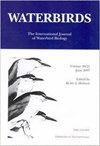自2006年以来,阿肯色州首次记录了国王Rail (Rallus elegans)的繁殖
IF 0.6
4区 生物学
Q3 ORNITHOLOGY
引用次数: 1
摘要
摘要不断变化的农业实践和湿地的丧失导致了美国东南部,包括阿肯色州东部密西西比河冲积河谷地区历史上的繁殖区,金Rail (Rallus elegans)种群数量的下降。尽管最近加强了协调努力,以改善对神秘沼泽鸟类的监测计划,并跟踪国王铁路的人口状况趋势,但在大部分历史上的繁殖范围内,成功观察到该物种的繁殖是罕见的。在2018年6月15日的实地考察和观鸟之旅中,我们在阿肯色州德沙县弗雷迪布莱克乔克托岛野生动物管理区鹿研究西部单元的紧急沼泽水库中获得了成年和幼年金Rails的照片记录(eBird Checklist S46788433)。这个新兴的沼泽湿地是通过湿地保护计划进行密集湿地恢复的产物。这是自2006年以来首次在阿肯色州观察到King Rail的繁殖情况。这一观察结果是对湿地保护计划的赞扬,并证明了湿地恢复对最受保护的物种的影响。最后,这一观察结果是对阿肯色州狩猎和鱼类委员会积极管理计划的赞扬,该计划旨在维护重要的新兴沼泽湿地栖息地条件,以便在繁殖季节为候鸟提供栖息地。本文章由计算机程序翻译,如有差异,请以英文原文为准。
First Documentation of King Rail (Rallus elegans) Reproduction in Arkansas Since 2006
Abstract. Changing agricultural practices and wetland loss have resulted in the decline in abundance of King Rail (Rallus elegans) populations throughout the southeastern United States, including within the historical breeding range of the Mississippi Alluvial Valley region in eastern Arkansas. Despite a recent increase in coordinated efforts to improve monitoring program for secretive marsh birds and to track trends in population status of the King Rail, successful observations of reproduction by the species are rare throughout much of the historical breeding range. During a field visit and birding trip on 15 June 2018, we obtained photographic documentation of adult and juvenile King Rails in an emergent marsh impoundment on the Freddie Black Choctaw Island Wildlife Management Area Deer Research West Unit in Desha County, Arkansas (eBird Checklist S46788433). This emergent marsh wetland is a product of intensive wetland restoration through the Wetland Reserve Program. This is the first documented observation of King Rail reproduction in Arkansas since 2006. This observation provides a tribute to the Wetland Reserve Program and demonstrates the impacts wetland restoration can have on species of greatest conservation concern. Lastly, the observation is a tribute to the active management program of the Arkansas Game and Fish Commission aimed to maintain important emergent marsh wetland habitat conditions for migratory waterbirds during the breeding season.
求助全文
通过发布文献求助,成功后即可免费获取论文全文。
去求助
来源期刊

Waterbirds
生物-鸟类学
CiteScore
1.30
自引率
0.00%
发文量
0
审稿时长
6-12 weeks
期刊介绍:
Waterbirds is an international scientific journal of the Waterbird Society. The journal is published four times a year (March, June, September and December) and specializes in the biology, abundance, ecology, management and conservation of all waterbird species living in marine, estuarine and freshwater habitats. Waterbirds welcomes submission of scientific articles and notes containing the results of original studies worldwide, unsolicited critical commentary and reviews of appropriate topics.
 求助内容:
求助内容: 应助结果提醒方式:
应助结果提醒方式:


